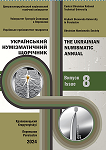A RARE COIN OF SULTAN MURAD IV (1623-1640) STRUCK IN THE MINT OF PROVADIA (BULGARIA)
A RARE COIN OF SULTAN MURAD IV (1623-1640) STRUCK IN THE MINT OF PROVADIA (BULGARIA)
Author(s): Nevyan MitevSubject(s): Archaeology, Museology & Heritage Studies, Regional Geography, Economic history, 17th Century, The Ottoman Empire
Published by: ДВНЗ Переяслав-Хмельницький державний педагогічний університет імені Григорія Сковороди
Keywords: Provadia; akce; sultan Murad IV; Bulgaria; mint;
Summary/Abstract: The rare coin was discovered during an inventory of the collection of the Historical Museum in the town of Provadia by the author of the present study. The purpose of the article is to publish the rare coin of Sultan Murad IV, struck in the Provadian Mint, is published. At the moment, no more than 10–15 pieces of these issues have been registered, but the specimen published here is the first that almost certainly originates from the Bulgarian lands and from the actual mint. The small number of coins that have reached the present day is explained by the poor quality, the small size and the fact that the inscriptions are faded, of-centred and non placed precisely on the core. The theoretical and methodological basis includes the application of scientific methods such as analysis and synthesis, comparison, and analogy. Additionally, the specific methods of the numismatic research have been employed, the metric measurement and iconographic analysis. Scientific novelty. Researchers associate the struck of the coins in the mints of Nicopolis and Provadia with the military campaign of Sultan Murad IV against Poland in 1634 (1043 AH). In the future, it can be expected that similar emissions will be discovered during archaeological excavations or in museum funds and private collections. These rare monuments of numismatics add to our knowledge of Ottoman coinage in the Balkans and, in general, of economic history during this period. Conclusions. The specimen published here adds to our known specimens from these rare issues. More importantly, although the coin was not found during archaeological excavations, it can be considered with a high degree of certainty that it originates from the Bulgarian lands. Although there is information about two of the above-mentioned specimens that they are kept in Bulgarian private collections, they could be subject to more doubt than our issue. And another thing – the coin originates precisely from the heart of this coinage, from the actual mint – Provadia. In any case, it can be expected that similar coins will be found both in Bulgaria and outside the borders of the country. These artifacts in themselves are valuable numismatic monuments, but on the other hand, they help to study in more detail the period of Ottoman rule both in the Bulgarian lands and in the Balkans in general.
Journal: Український Нумізматичний Щорічник
- Issue Year: 2024
- Issue No: 8
- Page Range: 203-207
- Page Count: 5
- Language: English

